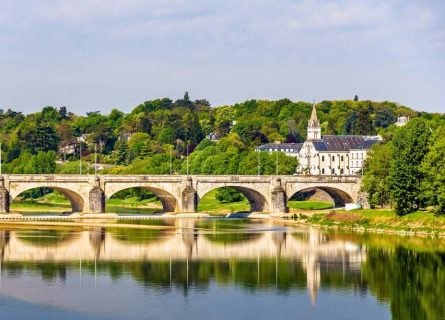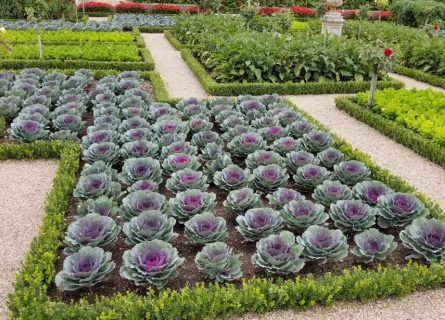Uncover Chinon's vibrant flavors and culinary gems with our expert guides. Plan an unforgettable trip now!
Read more
EXPLORE ALL OUR LOIRE VALLEY WINE REGIONS GUIDE
Last updated: April 4, 2025
Vouvray is a quintessential Loire Valley region: dynamic, beautiful, and multifaceted. Its signature grape variety, Chenin Blanc, produces diverse styles, including a demi-sec still white, intensely sweet moëlleux wines, and a great deal of fizz (over 55% of total production). But even sparkling Vouvray comes in several guises – pétillant offers a gentle effervescence in contrast to the powerful, vivacious bubbles of a fully sparkling mousseux style.
Meanwhile, the still-dry whites are often of good value and reliably fruity. But Vouvray’s global reputation increasingly rests on providing an affordable, delicious, and widely available alternative to Champagne.
Discover More About French Wine

Viticulture and religion have long played important roles in the economic and cultural life of the Touraine region. After the Romans conquered Gaul in the last century BC, the city of Tours, situated just to the west of the commune of Vouvray, became one of their key strategic and trading outposts.
But in addition to its importance as a center of commerce, Tours became a hub of Christianity in the 4th century under St. Martin. According to legend, the devout priest founded the Abbey of Marmoutier in 372 and, finding the conditions agreeable, decided to plant vines on its expansive grounds. In AD 476, the Western Roman Empire collapsed into chaos, yet winegrowing would endure throughout the centuries, notwithstanding the violence of the Dark Ages.
Chenin Blanc’s Emergence in the Middle Ages
However, the first mention of Chenin Blanc and its wines did not occur until the Middle Ages. Wine historians believe the grape originated in the city of Anjou, known locally as Pineau de la Loire; the 16th-century humanist author François Rabelais thus described it:
“O this lovely white wine! By my soul, it’s such a silky, soft wine.”
Transported to the vineyards of Vouvray sometime in the 13th century, Pineau thrived in the calcareous tuffeau soils of the Middle Loire.
Meanwhile, Tours became France’s capital in 1461 under the orders of Louis XI. Successive monarchs took up residence in the majestic chateaux of the Loire Valley, including the splendid Chateau de Blois, once home to Louis XII, Francois I, and Henri III. Their fondness for the sweet wines of Vouvray turned Loire Chenin into one of France’s most sought-after and prestigious whites. However, Tours fell out of favor with the monarchy during Henri IV’s reign, leading to the naming of Paris as France’s new capital.
The Rise of Sparkling Wines
By the 1800s, the ‘secret’ of making traditional method sparkling wines had leaked out of Champagne and became a nationwide phenomenon. Taking advantage of the ancient caves of the Touraine region, producers built subterranean cellars to age their bottles in the naturally cool, dry conditions of the excavated tuffeau rock. Awarded appellation status in 1936, the atmospheric caves of Vouvray remain one of the region’s most popular tourist attractions.

Vouvray is a séductrice: a land of rolling hills, sophisticated towns, renaissance chateaux, and magnificent white wines. The nearby town of Blois boasts a pedestrianized old quarter full of romantic courtyards and fine restaurants. Vieux Tours competes on similar grounds with its narrow streets lined with half-timbered houses.
But most important of all are the vineyards – just over 2,300 hectares planted on the north bank of the Loire. They are cultivated on low hills of soft tuffeau limestone that flank the river from Noizay to Rochecorbon, two of the area’s most respected communes.
Climatic Challenges
For centuries, growers have been harvesting unctuously sweet grapes (either due to long hang times or botrytis) to create bottles of liquid gold that can last for many decades in bottle. The area’s hybrid continental-maritime climate, heavily influenced by the myriad of small streams and tributaries that dissect the vineyards of Vouvray, helps to encourage the spread of botrytis by evaporating and forming mists during the fall.
Yet local weather patterns are notoriously capricious – some vintages are warm and sunny while others (2013 springs to mind) are rain-soaked nightmares. Thus, the character of Vouvray, both dry and sweet, can vary dramatically from year to year; certain vintages yield very light and acidic whites. However, hot years such as 2018 resulted in a healthy crop of very dense and concentrated wines.
Vineyards of Vouvray
Like Anjou and Saumur, Vouvray is renowned for its tuffeau calcareous soils: porous, permeable, and rich in minerals. Many top climats (vineyard sites) are found on south-facing slopes in shallow valleys north of Vouvray town. These are among Europe’s most famous Chenin Blanc vines, cultivated on shallow gravel beds that overlie deep bands of riverside tuffeau.
Local growers have long distinguished between two distinct forms of this ancient limestone: tuffeau blanc and tuffeau jaune. The former is typically a relatively firm and chalky terroir, in contrast to the soft, crumbly tuffeau jaune limestone. It is said that the most powerful and structured wines require tuffeau blanc in the subsoil.
However, despite the apparent advantages, Vouvray has yet to undertake a codified classification of its terroir. Nonetheless, labels occasionally mention single vineyards, particularly Le Haut Lieu, Le Mont, and Clos du Bourg—a Holy Trinity of mesmerizing and long-lived Chenin Blanc wines.

Its incredible longevity has long distinguished vouvray sweet Chenin Blanc. Yet the winemaking employed to make these exquisite dessert wine styles, a heady concoction of fruit, acid, and alcohol, is relatively simple.
The Chenin Blanc berries are hand-picked in much the same way as in Sauternes: multiple passes through the vineyard are necessary to determine which grapes – or bunches – are sufficiently affected by botrytis or have ripened to a sufficient degree on the vine. In the latter’s case, the grower looks to the average must weight or degree of Baume (sugar) to categorize the resulting wine. Indeed, the appellation rules include several designations that reference sugar levels, namely Sec, Sec-Tendre, Demi-Sec, and the sweetest moëlleux whites.
Iconic Sweet Chenin Blanc: A Delicate Balance of Grapes and Botrytis
After harvesting, workers crush and press the grapes, releasing sugar-rich juice into the holding vat. This must is often clarified by chilling, and sulfur dioxide is added to protect against oxidation. Winemakers commonly ferment the juice in either stainless steel, concrete vats, or sometimes old oak barrels or even amphorae, which are currently in fashion among younger winemakers. If the must is particularly rich in sugar, starting the vinification can sometimes be challenging; the sweeter the juice, the slower and more reluctant the fermentation will be.
Transformation of Sugar into Liquid Gold
But if all goes well, the yeast will begin to devour glucose in the wine – the process is halted by chilling the liquid (and/or adding sulfur), ensuring that all the sugar is not converted to alcohol. As with Sauternes, malolactic fermentation does not occur as it can produce high levels of undesirable volatile acidity. The wines are then racked, fined, and usually filtered before they are bottled in the spring after the harvest. Bottle age will subsequently work its magic, transforming youthful exuberance into a cacophony of tertiary flavors: honeysuckle, beeswax, quince, and caramel.
Dry Whites and Sparkling Wines
Of course, such wines are only appreciated by a minority of consumers today. As a result, aromatic dry whites and sparkling are Vouvray’s main cash cows, produced using a fairly standardized paradigm. Still wines are typically fermented in stainless steel at low temperatures and bottled at a fairly young age; the most expensive cuvees are usually matured in oak for about 12 months or so, which can add a welcome dimension of richness and textural weight to top-quality Chenin.
Meanwhile, every bottle of sparkling Vouvray is produced using the traditional method (secondary fermentation in bottle) and aged for a minimum of nine months on the lees. However, prestige labels are often left in the cellar for several years before disgorgement, blended with reserve wines from good years to ensure consistency in quality. The best Vouvray is quite delicious: fruit-driven and very fresh sparkling wine.
Yet, unlike Champagne, it comes in a full and semi-sparkling version, known as mousseux and pétillant. This is determined by the amount of sugar added to the wine before the onset of secondary fermentation – higher levels of sugar result in more carbon dioxide in the wine. Thus, a modest amount of sugar will be used in the liqueur de tirage to create a pétillant fizz, bottled under less pressure. They are often the most stylish and fragrant of Vouvray’s sparkling wines, although relatively little is made nowadays.
In the 19th century, Vouvray rightfully earned its reputation as one of Europe’s finest sweet wines. Only the top First Growths of Sauternes – and possibly German Trockenbeerenauslesen – could rival its depth, complexity, and awesome longevity. Indeed, sharing a bottle of mature sweet Vouvray is a magnificent experience for oenophiles and connoisseurs as you take a delicious journey into the past.
The structure of Vouvray rests on sugar and acid rather than merely sugar and alcohol. This acidity allows for a prolonged and enjoyable aging process. It’s rare to come across a bottle that has aged too much for enjoyment unless it was produced in the early 1900s. But even the occasional centenarian can surprise you, offering aromas of dried fruits, crème brulee, and a panoply of earthy, spicy flavors. Such wines are unique in the Loire Valley and deserve to be treasured.
A Changing Landscape
Unfortunately, moëlleux Vouvray is an increasingly rare sight in the wine shops of Paris and New York as healthier lifestyles and shifting priorities take their toll on the sweet wine market. Yet the international demand for high-quality sparkling wine is booming: Vouvray is becoming an appellation defined by its traditional bubbly method rather than its former sweet glories. And from the perspective of the consumer, that is no bad thing.
Evolution From Sweet to Bubbly
This is not a question of championing the decline of classical styles – the world needs more affordable fizz, and Vouvray is well-positioned to cater to that demand. Moreover, unless you’ve been hiding underground for the past three years, you cannot fail to notice that NV Champagne, as wonderful as it is, is becoming rather expensive; rampant inflation has affected many houses in the region, as energy and fuel prices rose sharply across the world. Meanwhile, well-made Loire bubblies are seldom expensive due to the far lower grape prices and costs of production.
Sparkling Charm: A Different Kind of Fizz
Of course, the flavor profile will scarcely resemble Champagne and its signature blends of Chardonnay, Pinot Meunier, and Pinot Noir: Chenin Blanc produces a far more aromatic, sparkling, vibrant, and fruit-driven style. Vouvray does not boast its own version of Krug or Dom Perignon. This is a bastion of democratic fizz, designed to revitalize a dull Wednesday evening with a touch of apple-scented effervescence. If tank-fermented Prosecco doesn’t float your boat, we guarantee this will.
Chenin blanc is a white wine grape varietal from France's Loire Valley Wine Region. It's a highly versatile grape that produces delicious, light-bodied wines.
Find out more
Often described as the ‘Garden of France,’ the Touraine region has earned the respect of visiting Parisians – no easy feat! This is mainly due to the area’s fantastic food scene, where classical dishes like coq au vin, pork rillettes, and superlative cheeses appear on chalkboards in (almost) every bistro in Tours and neighboring Vouvray. Expect a lively atmosphere and delectable food on tap, prepared by chefs passionate about honest, straightforward cooking.
A Guide to the gastronomy and Cuisine of Loire: Read more
If you would like us to customize an exclusive luxury tour, contact us and let us know your travel plans. We offer luxury food and wine tours for private groups of a minimum two guests. In addition, all of our private, chauffeured tours are available year-round upon request.

